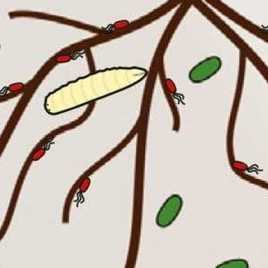BeneComb
Biological control of soilborne insect pests using combinations of pseudomonads, nematodes, and fungi (BeneComb)
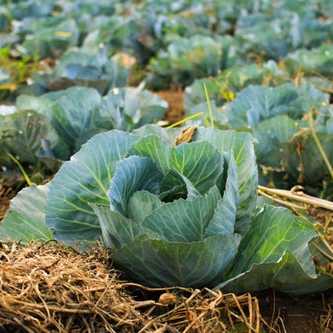
Project Start: 2018
Principal Investigator: Dr. Monika Maurhofer, Plant Pathology
Co-Investigators: Dr. Anouk Guyer, Agroscope; Dr. Giselher Grabenweger, Agroscope
Contact: Dr. Monika Maurhofer
This project aims to develop a new approach for biological control of soil-dwelling pests compatible with organic production. The first aim is to evaluate the potential of plant-beneficial fluorescent Pseudomonas bacteria with entomopathogenic activity for insect control. The second aim is to investigate whether below-ground insect biocontrol can be improved by combining these Pseudomonas with well-established biocontrol agents such as fungi and nematodes.
Below ground insect pests have for decades been controlled with persistent, broad spectrum insecticides, with devastating side-effects on non-target insects and the soil microbiome. Recently, most of these pesticides have been banned in Europe, due to raising concerns for environmental and consumer safety. This has, however, left farmers without any options to control rising populations of soil pests, which threaten quantity and quality of agricultural produce. This project aims at developing a new approach for the biological control of soil-dwelling pests compatible with organic production. Our first aim is to evaluate the potential of plant-beneficial fluorescent Pseudomonas bacteria with entomopathogenic activity (EPP) for insect control as new non-Bacillus bacterial biocontrol agents (BCA’s) with a different mode of action. The second aim is to investigate whether below-ground insect biocontrol can be improved by combining EPP with entomopathogenic fungi (EPF) and entomopathogenic nematodes (EPN), which are already well-established BCA’s used in organic production. In lab experiments we will study the interaction of the three BCA’s and test the hypothesis that EPF and EPN can serve as vectors delivering the bacteria into the insect larvae thus intensifying or speeding up the killing effect of EPF and EPN alone. We will then test promising EPP-EPF-EPN combinations in greenhouse trials and on infested farmer’s fields against the cabbage root fly Delia radicum, a pest causing increasing losses in the production of brassicacean crops and for which no satisfactory control measures exist. This project combines fundamental research at ETH Zurich with applied agricultural research at Agroscope. We expect to provide i) new methods based on the combined application of beneficial soil organisms for the control of an important insect pest in organic and conventional vegetable production, which may be adapted to other problematic soil pests and ii) exciting new insights into complex interactions between agriculturally important members of the soil and rhizosphere ecosystem.
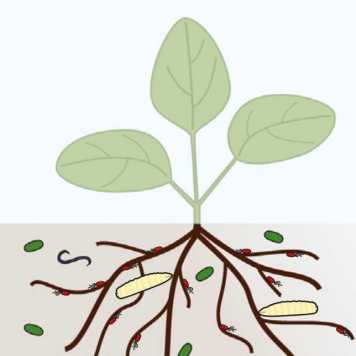
Publication in Agriculture, Ecosystems & Environment (2023)
external page Combining entomopathogenic Pseudomonas bacteria, nematodes and fungi for biological control of a below-ground insect pest by Spescha, A. et al.
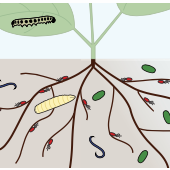
Poster Presentation at International Congress on Plant Pathology (2023)
Download When competitors join forces: using consortia of entomopathogenic Pseudomonas bacteria, nematodes and fungi for pest control (PDF, 1.5 MB) by Spescha, A., et al.
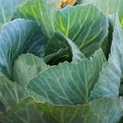
Publication in Microbial Ecology (2023)
external page When competitors join forces: Consortia of entomopathogenic microorganisms increase killing speed and mortality in leaf- and root-feeding insect hosts by Spescha, A. et al.

Poster Presentation at the Food Day @ETH 2021
external page Biological Control: Fighting below ground insect pests with entomopathogenic Pseudomonas bacteria, nematodes and fungi, by A. Spescha et al.
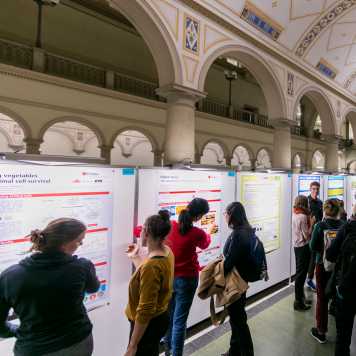
Poster Presentation at World Food System Center Research Symposium 2019
Download Biological Control: Fighting below ground insect pests with entomopathogenic Pseudomonas bacteria, nematodes and fungi (PDF, 2.7 MB), by A. Spescha et al.
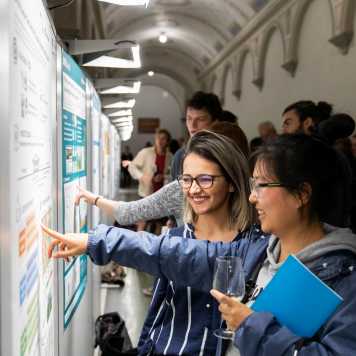
Poster Presentation at World Food System Center Research Symposium 2018
Download Biological Control: fighting below ground insect pests with Pseudomonas bacteria (PDF, 2.1 MB), by A. Spescha et al.
